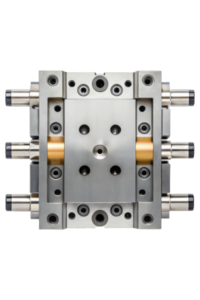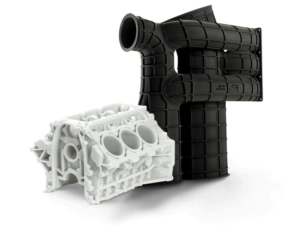Metal 3D printing, also known as Additive Manufacturing (AM), has witnessed incredible progress in recent years, pushing the boundaries of possibility and transforming various industries. Quickparts takes you on a journey into the forefront of this technology, exploring the advancements in metal 3D printing, its industrial applications, and the boundless potential that lies ahead.
Precision and Geometry: comparing offerings – CNC vs. 3D:
CNC machining offers higher overall precision, typically achieving tolerances in the range of micrometers (0.001 mm) and even tighter with advanced machines.
Depending upon technology used, 3D metal printing, on the other hand, isn’t quite as tight on the tolerance points. Powder Bed Fusion (PBF) methods: Like Selective Laser Melting (SLM) and Electron Beam Melting (EBM) achieve tolerances around 50-150 microns (0.05-0.15 mm), with newer machines reaching 20-30 microns. Binder Jetting methods offer lower precision around 200-500 microns (0.2-0.5 mm) due to the nature of the process.
Where metal 3D printing does have the advantage, however, is when it comes to complex geometries. The technology allows for allows for intricacy with a level of accuracy that was once unimaginable. It is also ideal for applications requiring lightweight parts as part consolidation and hollowing out whilst retaining a strengthening lattice structure is feasible without resorting to costly, and wasteful, high-level multi-axis machining or bonding parts.
This means that metal printing is absolutely a viable alternative to machined, forged or cast metal part production.
Industrial Applications of Metal 3D Printing:
- The impact of metal 3D printing extends across a spectrum of industrial applications, revolutionizing sectors such as aerospace, automotive, healthcare, and beyond.
- Aerospace: Craft lightweight and high-strength components with intricate structures, enhancing overall performance and fuel efficiency.
- Automotive: Engine components, lightweight structures, and customized parts are manufactured with precision, contributing to the evolution of automotive design.
- Healthcare: Implants, prosthetics, and specialized medical devices are crafted with patient-specific precision, reducing costs and improving patient outcomes.
- Energy: Metal 3D printing enables the creation of complex parts for turbines and energy-efficient components, driving advancements in the energy sector.
Future Potential: Paving the Way for Tomorrow’s Innovations:
Metal 3D printing has hitherto been slow to evolve, and we’ve only started seeing advancements in the technology in the last five to ten years. Many direct metal printing platforms (DMP) such as those used by Quickparts are in fact open platforms, meaning it’s neither difficult, nor expensive to change materials regularly. This paves the way for engineers to review metal printing in terms of:
- Expanding Material Variety: The range of printable metals is constantly expanding, now including titanium alloys, nickel alloys, Inconel, copper, and even precious metals like gold and silver. This enables production of parts with diverse properties for various applications.
- Multi-material printing: Techniques like Binder Jetting allow printing objects with different metals within the same part, enabling tailored properties and functionalities in a single build.
- Increased Speed and Accuracy: Newer technologies like Electron Beam Melting (EBM) offer significantly faster printing speeds and improved accuracy, making them ideal for high-volume production.
- In-situ process monitoring: Real-time monitoring of the printing process through sensors and AI helps ensure quality control and detect potential defects early on.
- Large-scale printing: Machines capable of printing larger metal parts are emerging, opening doors for applications in shipbuilding, aerospace, and construction.
- Hybrid manufacturing: Combining 3D printing with traditional techniques like machining enables creating complex geometries with high-precision finishes.
- Bioprinting with metals: Researchers are exploring printing tissues and organs with biocompatible metals, paving the way for personalized medicine advancements.
Sustainability in Metal 3D Printing:
Quickparts is committed to sustainability in manufacturing. Metal 3D printing minimizes material waste, enhances energy efficiency, and provides a more eco-friendly alternative than traditional methods, aligning with the global shift toward sustainable practices. As more recycling occurs across the industry, from powder production to part replacement, we’ll be sure to embrace it.
Download our DMP fact sheet for more details.


